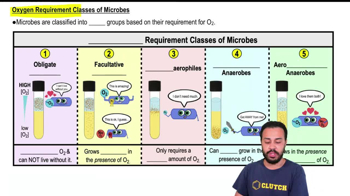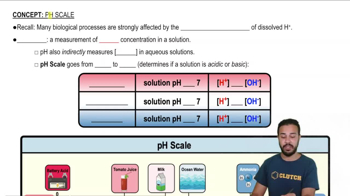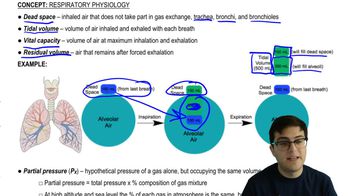Table of contents
- 1. Introduction to Biology2h 40m
- 2. Chemistry3h 40m
- 3. Water1h 26m
- 4. Biomolecules2h 23m
- 5. Cell Components2h 26m
- 6. The Membrane2h 31m
- 7. Energy and Metabolism2h 0m
- 8. Respiration2h 40m
- 9. Photosynthesis2h 49m
- 10. Cell Signaling59m
- 11. Cell Division2h 47m
- 12. Meiosis2h 0m
- 13. Mendelian Genetics4h 44m
- Introduction to Mendel's Experiments7m
- Genotype vs. Phenotype17m
- Punnett Squares13m
- Mendel's Experiments26m
- Mendel's Laws18m
- Monohybrid Crosses19m
- Test Crosses14m
- Dihybrid Crosses20m
- Punnett Square Probability26m
- Incomplete Dominance vs. Codominance20m
- Epistasis7m
- Non-Mendelian Genetics12m
- Pedigrees6m
- Autosomal Inheritance21m
- Sex-Linked Inheritance43m
- X-Inactivation9m
- 14. DNA Synthesis2h 27m
- 15. Gene Expression3h 20m
- 16. Regulation of Expression3h 31m
- Introduction to Regulation of Gene Expression13m
- Prokaryotic Gene Regulation via Operons27m
- The Lac Operon21m
- Glucose's Impact on Lac Operon25m
- The Trp Operon20m
- Review of the Lac Operon & Trp Operon11m
- Introduction to Eukaryotic Gene Regulation9m
- Eukaryotic Chromatin Modifications16m
- Eukaryotic Transcriptional Control22m
- Eukaryotic Post-Transcriptional Regulation28m
- Eukaryotic Post-Translational Regulation13m
- 17. Viruses37m
- 18. Biotechnology2h 58m
- 19. Genomics17m
- 20. Development1h 5m
- 21. Evolution3h 1m
- 22. Evolution of Populations3h 52m
- 23. Speciation1h 37m
- 24. History of Life on Earth2h 6m
- 25. Phylogeny2h 31m
- 26. Prokaryotes4h 59m
- 27. Protists1h 12m
- 28. Plants1h 22m
- 29. Fungi36m
- 30. Overview of Animals34m
- 31. Invertebrates1h 2m
- 32. Vertebrates50m
- 33. Plant Anatomy1h 3m
- 34. Vascular Plant Transport2m
- 35. Soil37m
- 36. Plant Reproduction47m
- 37. Plant Sensation and Response1h 9m
- 38. Animal Form and Function1h 19m
- 39. Digestive System10m
- 40. Circulatory System1h 57m
- 41. Immune System1h 12m
- 42. Osmoregulation and Excretion50m
- 43. Endocrine System4m
- 44. Animal Reproduction2m
- 45. Nervous System55m
- 46. Sensory Systems46m
- 47. Muscle Systems23m
- 48. Ecology3h 11m
- Introduction to Ecology20m
- Biogeography14m
- Earth's Climate Patterns50m
- Introduction to Terrestrial Biomes10m
- Terrestrial Biomes: Near Equator13m
- Terrestrial Biomes: Temperate Regions10m
- Terrestrial Biomes: Northern Regions15m
- Introduction to Aquatic Biomes27m
- Freshwater Aquatic Biomes14m
- Marine Aquatic Biomes13m
- 49. Animal Behavior28m
- 50. Population Ecology3h 41m
- Introduction to Population Ecology28m
- Population Sampling Methods23m
- Life History12m
- Population Demography17m
- Factors Limiting Population Growth14m
- Introduction to Population Growth Models22m
- Linear Population Growth6m
- Exponential Population Growth29m
- Logistic Population Growth32m
- r/K Selection10m
- The Human Population22m
- 51. Community Ecology2h 46m
- Introduction to Community Ecology2m
- Introduction to Community Interactions9m
- Community Interactions: Competition (-/-)38m
- Community Interactions: Exploitation (+/-)23m
- Community Interactions: Mutualism (+/+) & Commensalism (+/0)9m
- Community Structure35m
- Community Dynamics26m
- Geographic Impact on Communities21m
- 52. Ecosystems2h 36m
- 53. Conservation Biology24m
40. Circulatory System
Gas Exchange
Problem 3a
Textbook Question
When you hold your breath, which of the following first leads to the urge to breathe? a. falling CO2 b. falling O2 c. falling pH of the blood d. rising pH of the blood
 Verified step by step guidance
Verified step by step guidance1
Understand the role of respiratory gases and blood pH in the urge to breathe. The body's respiratory system is closely monitored by chemoreceptors that respond to changes in the concentration of gases and the pH of the blood.
Recognize that CO2 levels in the blood affect the pH. When CO2 levels rise, it reacts with water in the blood to form carbonic acid, which dissociates into hydrogen ions and bicarbonate, lowering the pH of the blood.
Identify that a lower blood pH (more acidic) due to increased CO2 is detected by central chemoreceptors in the brain. These chemoreceptors respond to the change in pH and send signals to increase the respiratory rate.
Note that while low oxygen levels (O2) can also stimulate the urge to breathe, this typically occurs under more severe conditions of oxygen deprivation. The primary drive under normal circumstances is the CO2 levels and the resulting pH change.
Conclude that the most immediate and sensitive response that leads to the urge to breathe is related to the rising levels of CO2 in the blood, which lowers the pH, rather than changes in oxygen levels.
 Verified video answer for a similar problem:
Verified video answer for a similar problem:This video solution was recommended by our tutors as helpful for the problem above
Video duration:
2mPlay a video:
Was this helpful?
Key Concepts
Here are the essential concepts you must grasp in order to answer the question correctly.
Carbon Dioxide (CO2) Levels
When you hold your breath, carbon dioxide (CO2) levels in the blood begin to rise due to continued cellular respiration. This increase in CO2 leads to a decrease in blood pH, making the blood more acidic. The body has chemoreceptors that detect these changes, and the urge to breathe is primarily triggered by elevated CO2 levels rather than low oxygen levels.
Recommended video:
Guided course

Carbon
Oxygen (O2) Levels
Oxygen levels in the blood are also important for regulating the urge to breathe, but they play a secondary role compared to CO2 levels. While a significant drop in O2 can eventually stimulate breathing, the body is more sensitive to changes in CO2. Therefore, the urge to breathe is typically felt before oxygen levels become critically low.
Recommended video:
Guided course

Oxygen Requirement Classes of Microbes
Blood pH and Acidity
Blood pH is a measure of acidity in the blood, which is influenced by the levels of CO2. An increase in CO2 results in a decrease in pH (more acidic), which is detected by chemoreceptors in the body. This drop in pH is a key factor that signals the respiratory center in the brain to initiate breathing, making it a crucial concept in understanding the urge to breathe.
Recommended video:
Guided course

pH Scale

 5:55m
5:55mWatch next
Master Gas Exchange and Breathing with a bite sized video explanation from Jason Amores Sumpter
Start learningRelated Videos
Related Practice





















